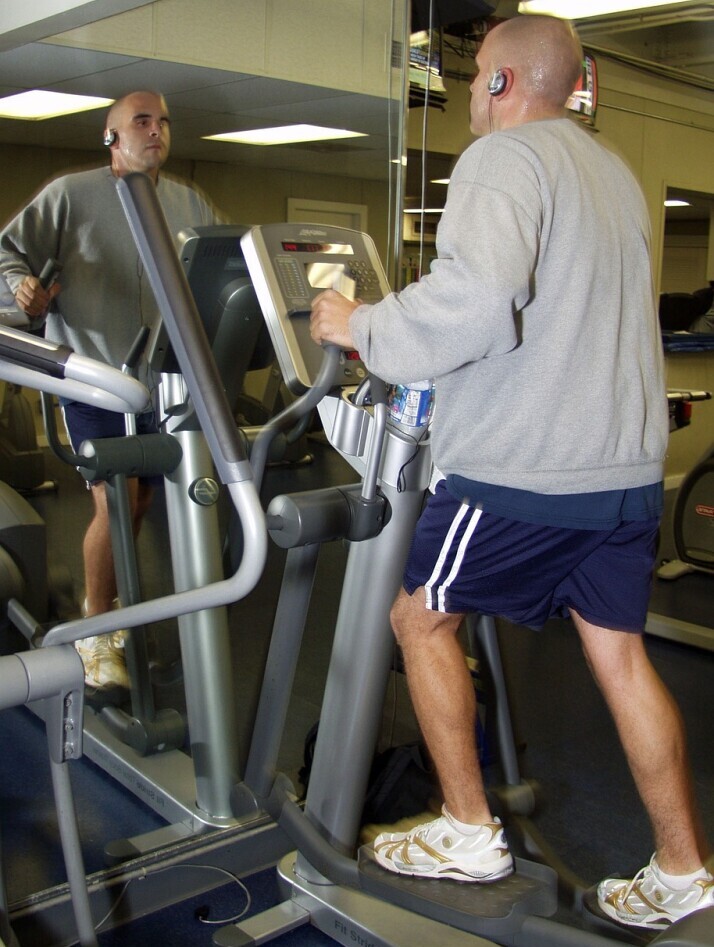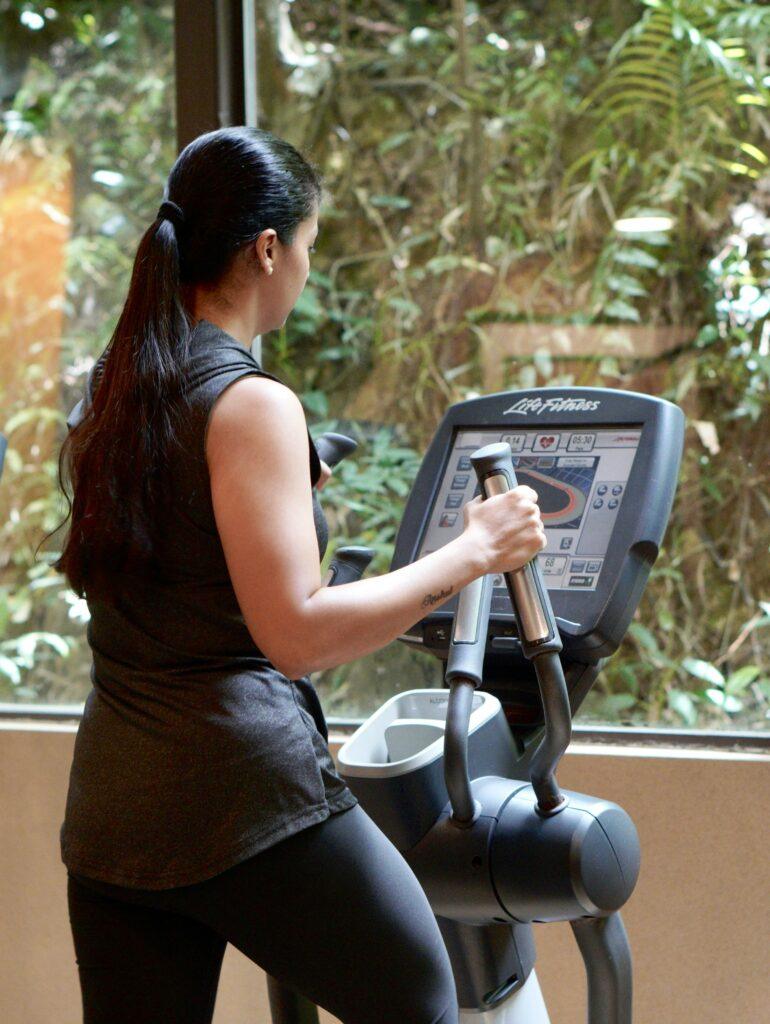
Ellipticals are pretty much a staple in any well equipped gym, and there’s a reason for that. They offer a low impact workout that’s easy on the joints while giving you a solid cardio session. Plus they’re great for a full body workout without the pounding that comes from running.
There are three main types of ellipticals which are rear drive, front drive, and center drive. Rear drive ellipticals are typically more compact and provide a longer stride, which can feel more natural. They’re great if you’re tight on space but don’t want to compromise on the workout experience. Front drive ones usually offer more incline settings, perfect for mimicking stair climbing. Then you’ve got the center drive ellipticals, the new kids on the block, which combine the stability of rear drive with the incline benefits of front drive, offering a balanced and dynamic workout experience.
When it comes to picking the right model, brands like NordicTrack, ProForm, and Schwinn often come up. Each has its strengths, so check out reviews and see what aligns with your fitness goals. Technology has also made its way into these machines, with features like virtual coaching and Bluetooth connectivity becoming pretty standard these days, turning your living room into a hight tech gym.
Choosing the right type depends on your fitness goals. If you’re all about ultra intense, calorie burning sessions, a front drive machine could be your best bet. For more stability and support while getting in a decent workout, the rear drive might be more your speed. And for those wanting a jack of all trades, center drive ellipticals offer versatility that’s hard to ignore. Bottom line, focus on what’s gonna keep you motivated, because at the end of the day, the best elliptical is the one you’ll actually use.
Key Features to Consider: From Comfort to Performance
When deciding on an elliptical, think about stride length. It’s a detail that folks often overlook, but it totally changes the workout game. If you’re taller, you might want a longer stride to avoid feeling restricted, while a shorter stride can suit those on the smaller side, giving a more comfortable, natural motion.
Adjustable resistance levels are your friend when you’re upping the workout ante. Having a machine that can grow with your fitness levels is crucial for consistent progress. Plus, it keeps things interesting so you’re less likely to ditch your routine out of sheer boredom.
Ergonomics play a huge role in comfort and efficiency, making pedal positioning and handlebar designs important factors. Check for pedals that pivot and cushioned handlebars to support your form. You don’t want to end up with an aching back or sore wrists after every session, right?
Modern ellipticals come with some sweet display features and integrated workout programs that make sweating it out way more fun. Whether you’re tracking your heart rate, following a virtual trail, or just jamming to your playlists, look for a machine with a user friendly interface that meets your entertainment preferences.
Noise level might not be the first thing you think about, but it matters if you’re in a shared space. You want a quiet machine that doesn’t disturb everyone else, especially if you’re an early bird or night owl.
Maintenance and warranty are like the trusty sidekicks of your elliptical. Regular upkeep ensures your machine runs smoothly for years to come, and a solid warranty gives peace of mind, covering repairs or part replacements when they’re eventually needed.
Ellipticals in Action: Tailoring Workouts for Maximum Effectiveness
Ellipticals are like the Swiss Army knives of cardio equipment versatile and incredibly effective when used right. One major perk of these machines is their calorie-burning potential. Depending on your weight and workout intensity, an elliptical can torch anywhere from 200 to 400 calories in just 30 minutes.
For those big on High-Intensity Interval Training (HIIT), ellipticals have got you covered. Alternating between periods of intense exertion and slow-paced recovery can vastly enhance your fitness levels, and ellipticals allow you to do this without the joint stress that often comes with HIIT on treadmills.
Besides the heart pumping benefits, ellipticals are fantastic for folks needing joint friendly exercises. Whether you’re a beginner,part of the seasoned set, the low impact nature of ellipticals means less strain while still engaging major muscle groups.
Most machines also come packed with built in fitness programs. Whether you’re targeting cardiovascular health, trying to shed a few pounds, or looking to tone up, these preset routines guide you in honing in on your specific fitness goals, all while keeping things fresh and exciting.
Incorporating an elliptical into a broader fitness routine is a smart move. Mixing it up with some strength training and flexibility work makes for a well rounded approach to fitness. After all, a healthy body isn’t just about endurance it’s also about building strength and maintaining flexibility.
Thanks for checking this post out feel free to to leave a comment, ask questions and be sure to look on the other posts for everything fitness.


Great breakdown of elliptical options and features! It’s super helpful to see the pros and cons of each type laid out so clearly. I love how this article emphasizes the importance of choosing a machine that aligns with personal fitness goals and highlights often overlooked factors like stride length, ergonomics, and noise levels. The advice on incorporating ellipticals into a broader fitness routine is spot-on—versatility and low-impact benefits make them a fantastic addition to any workout plan. Thanks for such a comprehensive and motivational read
Thank you for such encouraging feedback! I’m thrilled you found the breakdown of elliptical options and features helpful. It’s great to hear that the focus on often overlooked factors like stride length, ergonomics, and noise levels resonated with you these details truly make a difference when choosing a machine that fits both your goals and lifestyle.
Ellipticals are indeed a fantastic addition to any fitness routine, offering a unique combination of low-impact exercise and versatility. Whether it’s cardio, endurance training, or active recovery, they’re perfect for a variety of goals without putting excessive stress on the joints.
If you ever have questions about selecting the right model, optimizing your workouts, or even blending elliptical sessions with other types of training, feel free to reach out I’m here to help! Thanks again for the kind words and for taking the time to share your thoughts.
This is a super informative breakdown of elliptical types and features! One question that came to mind is about the maintenance you mentioned—are there any specific parts on an elliptical that tend to wear out faster and require regular attention? Also, for someone new to using ellipticals, how important is it to test stride length before purchasing, and are there ways to adjust it if it feels off after buying?
hank you for your thoughtful feedback! I’m glad you found the breakdown helpful. Let’s tackle your excellent questions:
Maintenance for Ellipticals: Common Wear Points
Ellipticals are generally low-maintenance, but there are a few parts that may require regular attention:
Drive Belt or Chain: These can wear out over time, especially with heavy use. Keep an eye on any signs of slipping or unusual noise.Rollers and Tracks: If your elliptical uses rollers on tracks, these can accumulate debris or wear unevenly. Regular cleaning and occasional lubrication can help.Pedals: The pivot points or hinges on the pedals can loosen or squeak, so check them periodically and tighten as needed.Electronics: Screens or consoles might require updates or troubleshooting if they lose calibration. Ensure battery replacements or power connections are in good condition.Bearings and Joints: Lubricate moving parts every few months to keep the motion smooth and prevent premature wear.
Stride Length: Why It’s Important and Adjusting Post-Purchase
Stride length is critical for comfort and effectiveness. A poorly matched stride can feel awkward or limit the range of motion, reducing the quality of your workout. Here’s what to keep in mind:
Testing Before Buying: If possible, try the elliptical in person to ensure the stride length suits your height and natural gait. Taller individuals typically prefer longer strides (20–22 inches), while shorter users may be more comfortable with a 16–18 inch range.Adjustability: Some ellipticals feature adjustable stride lengths, which can be a great solution if multiple users share the machine or if your stride feels off after purchasing.Post-Purchase Tweaks: If stride length isn’t adjustable and feels awkward, adjusting the pedal position or experimenting with workout posture can sometimes help. If that doesn’t work, consider contacting the manufacturer about potential add-ons or modifications.